How the search for missing pieces of a British-era neglected fountain in Mumbai led the restoration team to a small English town, and a twin that had suffered a worse fate

Fitzgerald Fountain marked the arrival of Sir William Robert Seymour Vesey-Fitzgerald, who served as Governor of Bombay from 1867 to 1872. Placed at the Metro junction in Dhobi Talao, it was later kept at the lawns of the Dr Bhau Daji Lad Museum in Bycull
How many countries does it take to fix a fountain? Well, if you take the case of the restoration of the Fitzgerald Fountain, currently underway at the lawns of Byculla-s Veermata Jijabai Udyan, the answer is two. One, to put the pieces together India and another to solve the jigsaw puzzle Britain.
Erected in 1867 at the Metro cinema junction in Dhobi Talao, the Fitzgerald Fountain - named so because it was meant to mark the arrival of Sir William Robert Seymour Vesey-Fitzgerald, who served as Governor of Bombay from 1867 to 1872 - was pulled down and placed at the lawns behind Dr Bhau Daji Lad Museum. Here, it was lying in decay when the Brihanmumbai Municipal Corporation BMC decided to restore it as part of a larger project taken up to restore all heritage structures with cultural value.
ADVERTISEMENT

One of the interesting features of the fountain — which has two basins for drinking water - is a maintenance door that opens inwards
Neglected since the 1960s, the cast-iron fountain, which also functions as a gas lamp, was commissioned by the Esplanade Committee, but doesn-t figure in the list of heritage monuments. The Bhau Daji Lad museum is listed as a Grade IIA site but no separate category was given to the fountain or any statues in its vicinity. Once restored, the BMC can put in an application to categorise it. Conservation architect Pankaj Joshi said, if categorised, it would fall under the Grade I heritage category. Three years ago, Joshi, who also heads the Urban Design Research Institute UDRI, was roped in as expert for the restoration project, which would be conducted along with members of the BMC-s Heritage Department.
At first inspection, the team realised that more than 200 parts of the structure were missing. Worse, they didn-t know what these missing pieces originally looked like.

Pic/Sanjay Adhav
From metal to metal
The team of 150, which includes Joshi, sculptor Deepak Paunikar and eight officials from the BMC, first tested the composition of the cast iron in the fountain. This took three months, but was an important activity since it ensured that the missing parts that would be recreated would be of the same composition.
For starters, the fountain was dismantled. "Many pieces had been damaged. The structure was tilting, corroded and close to collapsing. The structure is built like a jigsaw puzzle and every piece has to be structurally stabilised before it can be fitted back together," said Joshi. To make things more challenging, the pieces would have to be refit in the same sequence they were dismantled. Like a Lego structure, the fountain would be structurally sound only if assembled in the correct order.
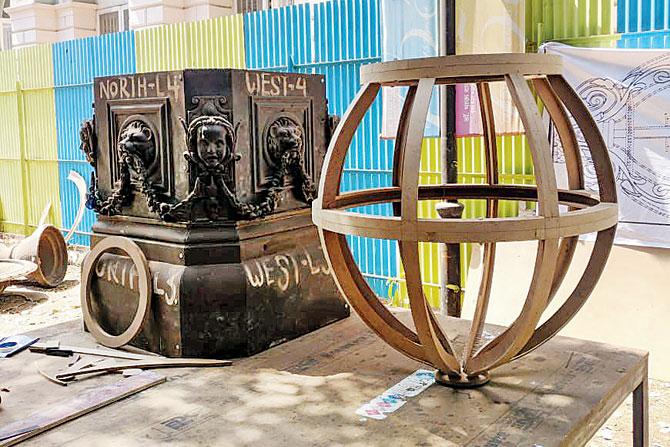
A wooden mockup of the lamp is being prepared to ascertain its size, design and scale
What helped the restoration team, said sub-engineer with the heritage department, Sanjay Adhav, was the symmetry of the 44-feet-tall structure. Adhav has the responsibility of supervising site work, including water engineering and constructing the foundation at Metro junction. "There are four identical parts to the fountain. If the missing element is present in any of the four parts, we can use that to cast moulds for the replicas," he said. Yet, if only one part of the four-piece puzzle was available, the team considered itself lucky. Adhav, who has been with the civic body for 22 years, said among the missing pieces was a six-feet tall lamp that once sat at the top of the structure.
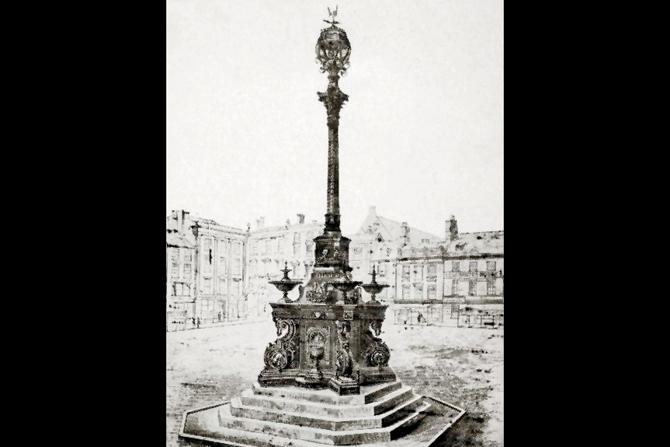
The fountain-cum-lamp in Northamptonshire was erected in 1863 to commemorate the marriage of Prince Albert to Princess Alexandra of Denmark. Interestingly, in the 1960s, the same time as the fate of its twin in Mumbai, it was removed due to repeated incidents of vandalism.
A piece in England
Where symmetry fell short, the Internet helped. Adhav and Sanjay Sawant, senior heritage conservator in the heritage department, scoured the web for images of the fountain from when it was still up and running. They also approached the officials at the Bhau Daji Lad Museum asking if they had any drawings or information about the Fountain. The officials then connected the restoration team with industrial archaeologist Peter Perkins.
A resident of Northamptonshire in Britain, Perkins had in fact, written to the Dr Bhau Daji Lad Museum a couple of years ago, inquiring about the Fitzgerald fountain. At the time, he was conducting research for his book on the products created at the Eagle Foundry in Northampton owned by an iron founder named Edward Harrison Barwell. From the museum, he wanted pictures of the Fitzgerald fountain, which bore a striking resemblance with the Market Square fountain, which stood in his town 80 miles north of London.
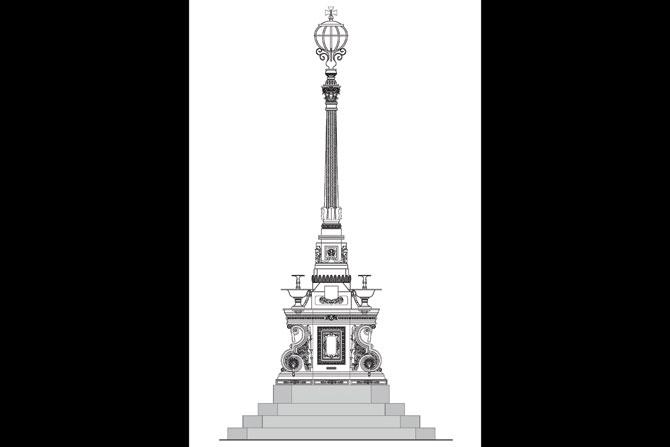
A sketch of what the restored fountain will look like
Market Square fountain was erected in 1863 to commemorate the marriage of Prince Albert to Princess Alexandra of Denmark, but was removed in 1962 due to repeated vandalism.
Hoping that he may benefit from Perkins-s expertise on the subject, Adhav wrote to him on October 30, 2018, requesting him to share any drawings of the design of the Market Square fountain. Four days later, Adhav received a picture from the National Archives at Kew in London. Adhav added that the BMC has written to the National Archives for permission to reproduce the sketch for the project. Armed with old images of both fountains, Joshi and team were able to visualise the structure. But, some pieces were still missing.
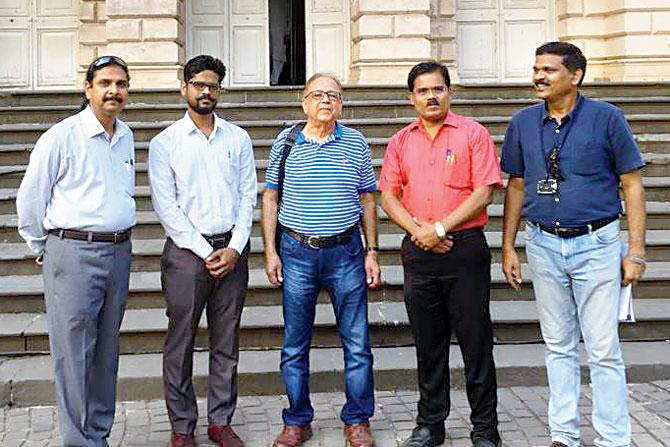
L-R Deepak Paunikar, Arun Kotnis in blue shirt in the centre, Sanjay Sawant and Sanjay Adhav have worked on the Fitzgerald project
A twin, yet unknown
In February, Adhav found the last piece of the puzzle. After dismantling the structure, he spotted a number engraved on the inner side of the four panels of the fountain. Perkins was able to shed light on the curious six-digit number. "The number was the patent or the design registration number and it matched the six digit number printed on the design drawing. We realised that the Fitzgerald fountain and the Market Square fountain are twins!"
Next to the patent number was a diamond registration mark. Perkins explained over email that this is used to ascertain the date on which the design was registered - January 25, 1864. Perkins pointed out that Barwell & Co had produced a wide range of ironwork over a period of more than 40 years. "A catalogue of their products contains designs for over 350 different items of ironwork, including large items such as bridges, decorative fencing and railings, water pumps, fire grates and stoves, architectural ironwork such as gates and railings as well as small objects like door plates and drawer handles," he said.
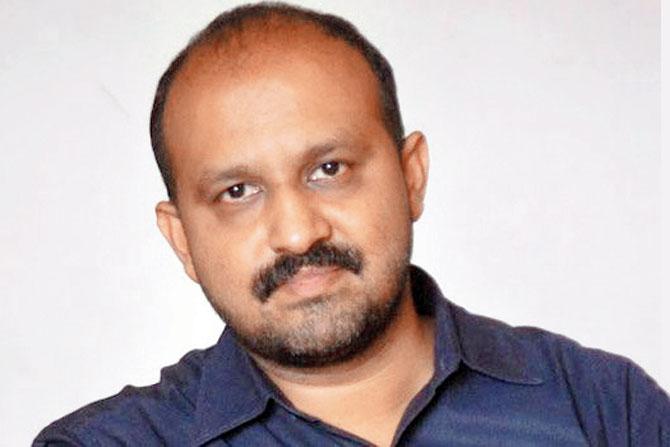
Pankaj Joshi, UDRI
About the Northampton fountain, he said, "Barwell & Co. registered the design with the British Patents Design and Trade Marks Office in 1864 when it was called a lamp pillar. However, their catalogue calls it a lamp and fountain, so it would appear to have had a dual function." On how one product landed in India, his guess is that someone here had a copy of the catalogue and placed an order.
All-India support
The lamp, Joshi said, still poses a challenge. "The lamp will have to be made using hand-blown glass, which is usually made in the foundaries of Moradabad." Currently, a wooden mock-up of the lamp is being prepared to ascertain its size, design and scale. It will then be made in cast iron like the rest of the structure. Adhav added that unlike its previous design, however, the lamp will no longer be fuelled by gas, and will get electrical lights as per heritage committee guidelines. Whether these will be LED or filament bulbs is a detail yet to be worked out.
But, Mumbai and Northhamptonshire and Moradabad are not the only cities involved in this project. While moulds for a few missing pieces are being prepared here, many others are currently being made in cast iron foundries of Ahmedabad, Jaipur and Bhiwandi. It-s only once all parts are in place, that the water engineering work will begin, said Adhav.
Finishing touches will include sand-blasting to remove corrosion, a process that is familiar territory for Deepak Paunikar, the sculptor picked for the project. Paunikar who has also worked on a similar gas lamp and fountain - the Khada Parsi statue at Byculla - says the final look of the heritage fountain is yet to be decided and the team is toying with three ideas. "One of the samples will be prepared with a chemical process which will give it an oxidised look, while another option is to wax and buff it to give it an antique look. The third option is to use a polyurethane coating which was used for Khada Parsi," he explained. Two countries, 152 years and a countless number of people with years of expertise behind them. That-s what it takes to fix a piece of history.
Fans of Fitzgerald
Arun Kotnis, a UK-based chartered town planner and architect, also a member of the Institute of Historic Building Conservation in UK, visited the fountain at Dr Bhau Daji Lad Museum last month accompanied by his wife. "I worked on the refurbishment of the Market Square some years ago.
The fountain [that was built] is the greatest achievement in cast iron engineering and I became interested in its history. We knew through our research on Northampton that there was an identical one in Mumbai. So, we started looking and found it five years ago," he said.
Excited to hear about the Mumbai restoration project, Kotni paid another visit on February 5. "It is commendable that the BMC is supporting such a bold and challenging project. When the BMC installs the fountain at the Metro junction, there should be sufficient space around to provide the setting it deserves," he added.
The fountain-s stats
1867
When the fountain/lamp helmed by Edward Harrison Barwell was erected at the Metro junction
44
Height in feetincluding the gas lamp
13
Width in feet
Catch up on all the latest Mumbai news, crime news, current affairs, and also a complete guide on Mumbai from food to things to do and events across the city here. Also download the new mid-day Android and iOS apps to get latest updates
 Subscribe today by clicking the link and stay updated with the latest news!" Click here!
Subscribe today by clicking the link and stay updated with the latest news!" Click here!







